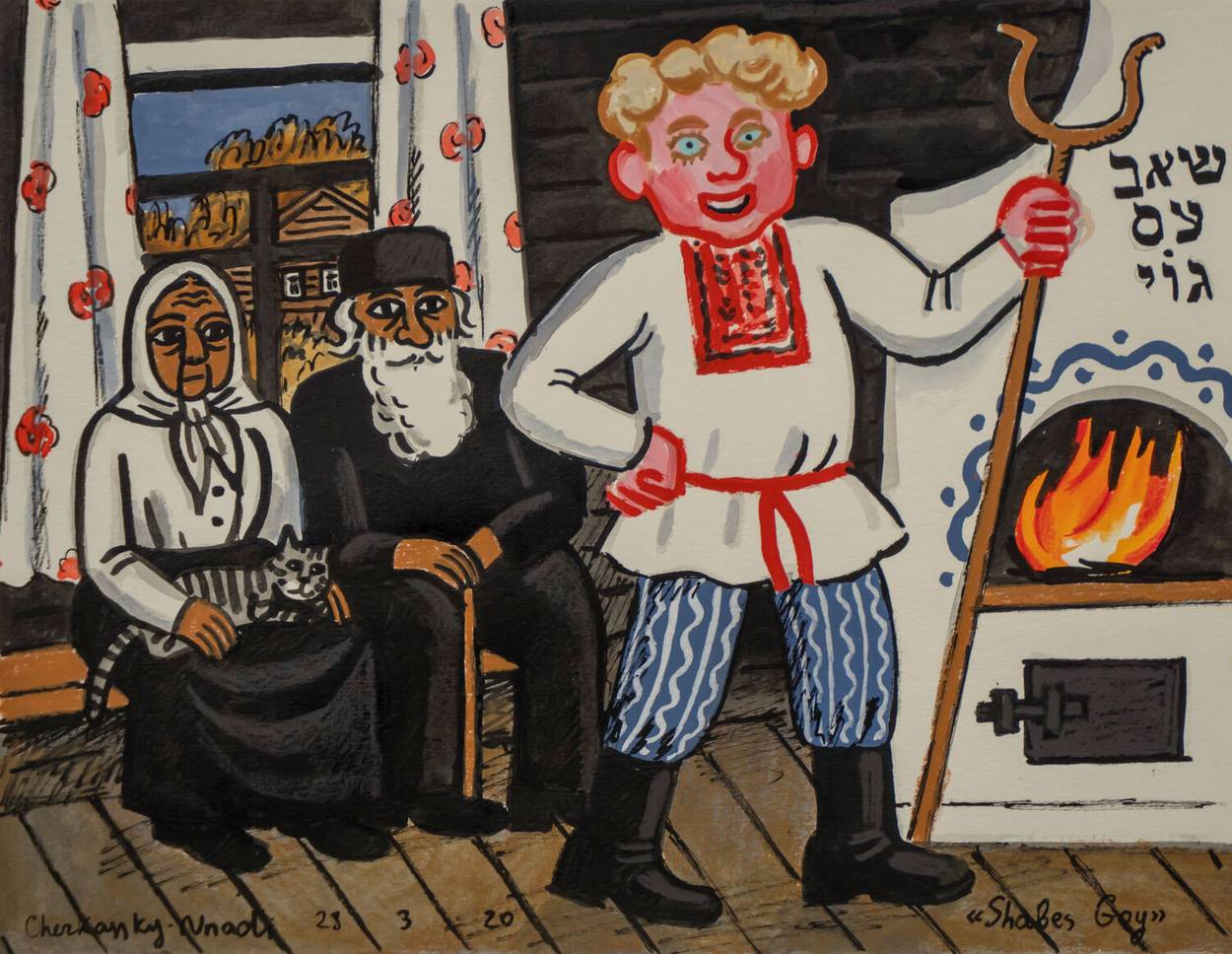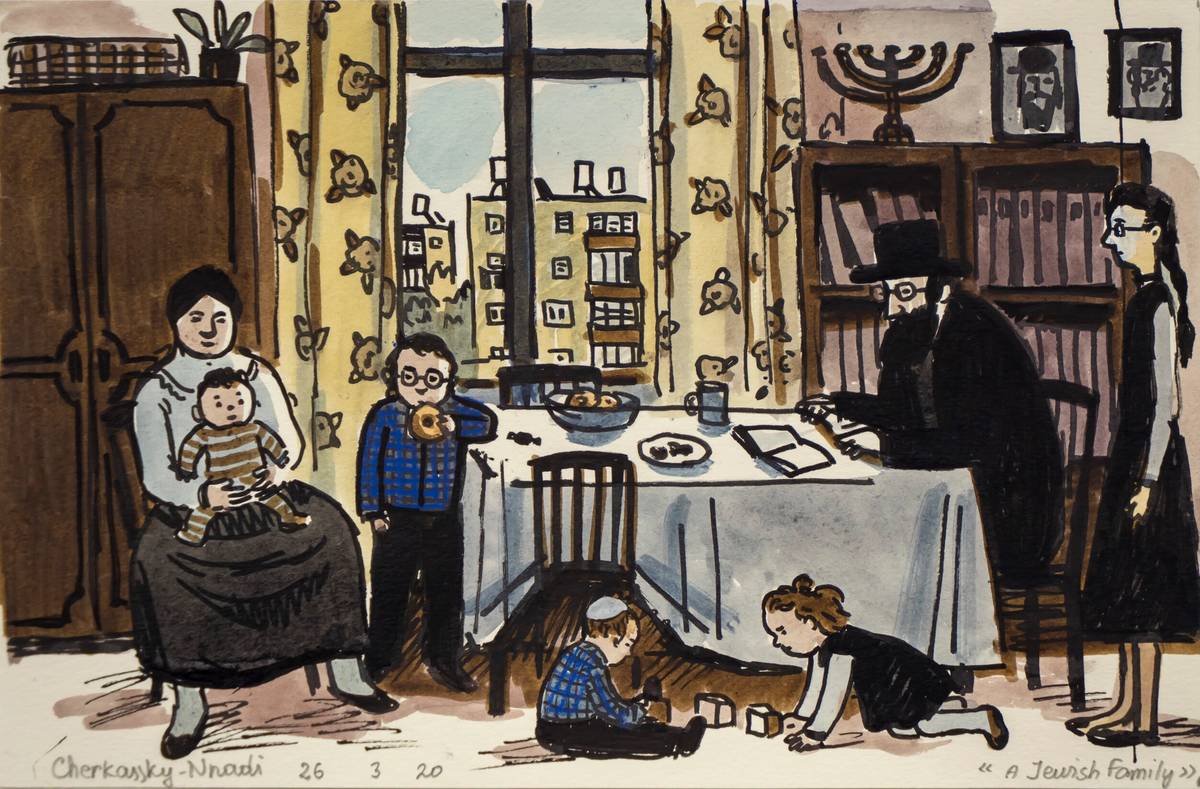Post-Soviet Jewish Punk Art
Zoya Cherkassky’s ‘return to reality’




In the “Year of the 11th Plague,” Zoya Cherkassky—the Ukrainian-born bad girl of Israeli art—makes an unexpected swerve into Chagall territory, albeit with a subtle punk twist. On first viewing, most of the 19 ink and watercolor drawings in Lost Time, an online exhibition that opened the first night of Passover, would hardly seem out of place hanging above the Seder plate-displaying breakfront in a 1950s Bensonhurst apartment. But, as with all of the 44-year-old artist’s work, there is an edge. The drawings were made at a rate of one per day, with Cherkassky self-quarantined in her Tel Aviv studio. They can thus be seen as a response to the global pandemic.
Cherkassky practices a form of sophisticated primitivism. A Jew in Ukraine but not, because of her mother’s lineage, considered one in Israel, the artist may be a perpetual outsider but hers is not at all outsider art. (Indeed, she got her training both at the National Academy of Art in Kyiv and the Thelma Yellin High School in Giv’atayim.) One of her many self-reflexive works is the diptych “School Mobbing” (2014) in which the identical, bespectacled, violin-clutching boychik is bullied as a Jew in Russia and as a Russian in Israel. One cannot fail to note that, scattered across the schoolyard, the Mozart score the boy was carrying is being casually pissed on.
As schematic and immediately readable as cartoons or advertising posters, Cherkassky’s images have an expressionist frisson. With their bright colors, bold outlines, flattened space, and simplified forms, her figurative drawings and paintings, many of which are enlarged cartoons, have affinities with both Ukrainian folk art and underground comix (although the caricatures she absorbed at an impressionable age came from the venerable Soviet humor magazine Krokodil rather than R. Crumb). Actually, Cherkassky is something of a rootless cosmopolitan. Brought to Israel at 15, she relocated to Berlin for several years in her early 30s (making a side trip to stir up trouble in Moscow). On her return to Israel in 2010, she founded a group with four other Soviet-born female artists called the New Barbizon, for the 19th-century French painters who advocated a movement out of the studio and a “return to reality”—in her case with a vengeance.
Known to Israelis simply as Zoya (or more formally, having taken the name of her Nigerian husband, Cherkassky-Nnadi), the artist has a gift for provocative stereotypes and, particularly in the series called Soviet Childhood, a phenomenal memory for evocative detail. The Israel Museum curator Mira Lapidot noted that if Israelis are “tone deaf” when confronted with Zoya’s Soviet Childhood, those “viewers who originate from the former Soviet Union are fully receptive to the Proustian ‘madeleines’ planted by the artist like so many clues in these works—typical food products, uniforms, or even school toilets.”

Lost Time, however, is different. Although nominally images of Europe, these drawings evoke a collective Jewish past, as much sentimental invention as historical truth. In dialogue with the curator, Alison M. Gingeras, Zoya calls her Jews “metaphysical”—by which she means theoretical constructs. Images like a cozy kheder with six adorable bokhers and their kindly old melamed, clustered before a woodburning stove inscribed, after the Yiddish song “Oyfn Pripichik,” or a dignified family out for a stroll in their bucolic shtetl might almost pass for shmaltz.
Drawings of a Tevye-type with a yellow Jewish star snuggling a less than animated goat, a domestic scene of an Orthodox family that could be titled “sheltering in place,” or the near-abstract “Open Air Minyan” in which 10 identically posed, socially distanced men daven in unison in an open field, are subtly disquieting. Only “Shabes Goy,” in which an insanely exuberant molodyets in an embroidered Ukrainian shirt and boots tends the fire for an ancient, nearly mummified Jewish couple, has a touch of the satire that made Cherkassky notorious in Israel.
Nothing in Lost Time is as confrontational as “The Circumcision of Uncle Yasha” (2013) in which a pair of Haredi mohelim in green surgical gowns loom over a middle-aged man lying on a hospital gurney. (Circumcision was prohibited in the Soviet Union.) Or as transgressive as “Aliyah of the 1990s” (2012) in which, crouched on all fours on a bed, a young blond woman strikes a pornographic pose. (In addition to illustrating the Israeli epithet “Russian whore,” the painting references Diego Velazquez’s mid-17th-century “Toilet of Venus.”) Given her gift for scathing social realism, Zoya’s retrospective Pravda—focusing on the lives of former Soviet immigrants to Israel and up for much of 2018 at the Israel Museum in Jerusalem—was a far greater provocation than Akiva Shtisel’s imaginary show of Haredi portraits.

Still, as cheery as the drawings of Lost Time are, there’s no missing the angst underlying Zoya’s drawing of a burning shtetl (an illustration of the Gebirtig poem “Undzer Shtetl Brent!”); her portrait of a mother and daughter with matching Jewish stars stitched to their blouses; or the three images referencing the “black” weddings held in 19th-century shtetl graveyards to ward off cholera. Although these might be considered old country customs, Zoya told Gingarus that she only learned of them in Israel when she saw a YouTube video of such a wedding being held in the early days of the pandemic in a cemetery outside Tel Aviv.
The notion, implicit in the image of a sad girl peering out a curtained window, that Anne Frank, to whom the portrait alludes, was also “sheltering in place” may be challenging. But the most outrageous and Zoyavian images illustrate the last verse of the beloved end of the Seder drinking song “Chad Gadya.” The angel of death who slew the butcher is a skeleton in a Waffen-SS uniform. The deity who slays the Angel of Death is Joseph Stalin.
That the Fort Gansevoort gallery is selling as well as exhibiting Zoya’s work online is certainly reflective of the new normal. Indeed, the artist is well versed in the use of social media. A brilliant manifestation of the old normal, however, may be found, also online, in two iterations of her recent show Soviet Childhood.
In an Israeli catalog devoted to early drawings from this series, Zoya connects the work to the birth of her daughter: “As I thought about her, I recalled my own childhood and made small drawings with felt pen on paper. These were my recollections of everyday life situations. … I wanted to express the most characteristic moments of the time when Soviet aesthetics still dominated the public space and yet the ‘pernicious influence of the West’ seeped profusely through the Iron Curtain.” Not surprisingly, the drawings were widely circulated—criticized as well as praised—on the Russian internet.

The images for Soviet Childhood might be illustrations for a children’s picture book. Many are portraits, mostly they are set in cramped apartments often around a kitchen table where, in “Voice of America” (2019), a bearded intellectual in bedroom slippers hunches over the radio, tea cup before him and cigarette in hand, or in “First Grade Teacher” (2019), a zaftig, bespectacled schoolmarm sits topless, grading her students’ workbooks. A whole subgenre has maternal-looking women in tiny kitchens making borsht or vareniki. Others ponder the generations, most vividly “Maverick” (2019), in which a teenaged punk wannabe, whose bedroom behind a makeshift partition (basically a wardrobe extended by a sheet) is marked by posters for AC/DC and Kiss, gets ready to go out while on the other side of the wardrobe, his father placidly reads a Russian newspaper and his mother covers her mouth, perhaps in disbelief.
Zoya has preferred types (bodybuilders in sweatpants, schoolgirls sneaking cigarettes) as well as several recurring characters. The skinny, sharp-featured hooker with blond hair pulled back in a tight ponytail, seen wearing a cheap denim pantsuit and oversized sneakers in the 2019 painting called “Marlboro,” for her shopping bag, also turns up with a friend singing in a nightclub. A middle-aged guy with glasses and a mustache who looks like the father in “Maverick” and could be the artist’s father as well, is seen stolidly centered in the group portrait “In the Bus” (2019) and relaxing in “Le Dejeuner sur l’Herbe” (2019), named after the once scandalous Manet picture, in which, as is their wont, Russians picnic in their underwear. The plump woman wearing a tank top emblazoned “CRAZY” in a number of paintings might be Zoya’s mother.

In some respects Soviet Childhood resembles the dissident Sots Art movement of the 1970s, and in their deadpan parodic use of clichés associated with Socialist Realism, particularly the urban landscapes painted by Eric Bulatov. However, Zoya is warmer, less ironic than satiric. “Golden Autumn” (2019) has a heroic, muscular mother, arm around her quizzical child as they stand on a tiny terrace, limned gazing out at an imposing wall of highrise apartment blocks.
Soviet Childhood has analogies to the “ostalgia” felt by former citizens of the German Democratic Republic and manifested in Communist theme clubs or bars, as well as coffee table art books devoted to East German tchotchkes. But again, Zoya’s attitude is different. Paintings like “80’s Disco” (2019) with its group of tentative revelers, or “Gastronom” (2019), setting a boxy Soviet supermarket amid glorious fall foliage, are as fond as they are disdainful.
Of course, Zoya’s evident affection for the “Red Atlantis” that sank beneath the waves in 1991 has nothing to do with ideology. Rather, the Soviet Union was the place—now lost—where the child Zoya first experienced herself and the world and thus, whatever else it might have been, an intimation of paradise.
J. Hoberman was the longtime Village Voice film critic. He is the author, co-author, or editor of 12 books, including Bridge of Light: Yiddish Film Between Two Worlds and, with Jeffrey Shandler, Entertaining America: Jews, Movies, and Broadcasting.